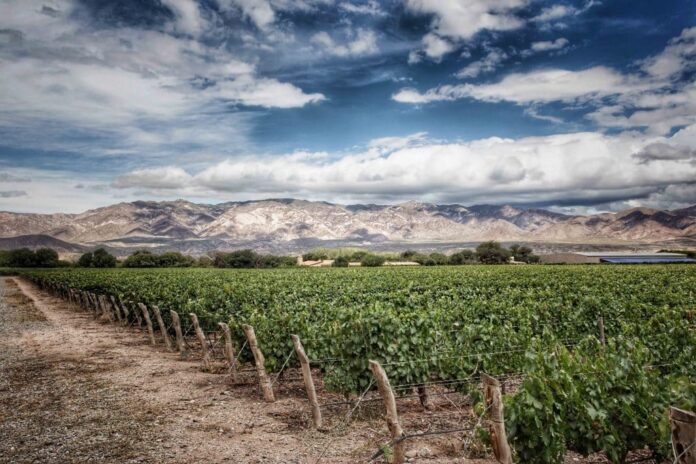The high-elevation vineyards in Argentina grow some of the world’s best expression of the Malbec grapes.
Courtesy photo
It began with a conversation with a friend from New York who is into both wine and skiing. He was checking out the ski pass offerings online and wanted to talk about which pass, the Epic or the IKON, might be his best bet for the upcoming ski season. As we perused the websites and the list of resorts that were on each pass, each of us sipping a glass of wine as we chatted, it occurred that looking at international ski mountains, those that are both epic and iconic, is a little bit like considering which wine regions meet the same descriptions of epic and iconic.

Aspen Skiing Co.
So the conversation shifted, and we began to discuss/debate the relative merits of the most well-known wine destinations on earth. A column was born.
Obviously making a list of the best wine regions, like that of ski resorts, is a subjective process that depends on what you like to drink and where you like to travel. But, if I had to create a “Wine Pass” that took me around the world of wine, it might include the following locales. In no particular order, here is a list of a six pack of global wine regions that would surely make anyone’s list of epic and iconic wine destinations, along with a note or two on the grapes, and some other things that you may not know.

Courtesy photo
Let’s start with what is perhaps the best-known wine in the world: Champagne. Whether you are a wine lover or not, everyone knows that Champagne represents both celebration and luxury. So iconic is the image of a fluted glass of bubbly that we, in the ski world, frequently use the word to describe the world’s lightest snow: “Champagne Powder.” And, get this: The phrase is actually a legally-trademarked description for the fresh snow that falls in Colorado, specifically from Steamboat, which had the audacity to take legal steps to describe their snow. In 2008, the Steamboat Ski and Resort Corporation actually registered “Champagne Powder” as an owned entity. Nevermind that the French region that grows Champagne is already protected by international law.
By that, I mean, in order for a winery to use the word “Champagne” as a description on a label or bottle, that wine must be produced within the confines of a relatively small area, not far from Paris, that holds the rights to the name Champagne. Sparkling wines — even if they use the same grapes (Pinot Noir, Chardonnay and Pinot Meunier) and the same method of production as is regulated in Champagne — still cannot use the word to identify their wines. Cava, Prosecco, Lambrusco and Cap Classique are examples of other international sparklers that, while they do not meet the official criteria and, therefore, may not use the Champagne moniker, are excellent wines.
Next on the list of the iconic regions of the world would have to be California’s Napa Valley, which is best known for its production of “cult” wines made from the Cabernet Sauvignon grapes that proliferate in the mountain and valley-floor vineyards. While Cabernet Sauvignon actually has its origins in the Bordeaux region of France, the grape has found both a home and a bold, uniquely California expression in what is perhaps the most luxury-oriented wine destination on earth. It is not unusual for Napa and Aspen to be discussed in the same breath when people are discussing desirable and iconic travel destinations. But, you knew that.
“But, I like it steep!” my friend said as he started to get excited about this exercise. Of course, that means that the next wine region on the Wine Pass would have to be the Mosel in Germany. There, the vines that provide vintners with the racy Riesling wines grow on terraced stone hillsides so steep that the workers who care for and harvest the grapes often must tether themselves to posts on either end of the rows. Otherwise, they will tumble to the river below. The steepest vineyard in the world is the Calmont near the German village of Bremm. It has slopes with up to 60-degree gradients. Consider that the steepest parts of the Highland Bowl, B1 and the Y zones, are about 45 degrees. Get the picture?
If you love wines from high elevations, then one region you want to be part of your epic and iconic Wine Pass would be the province of Salta, high in the Andes of Argentina. While there are wineries that are higher in elevation (think Tibet), Bodega Colomé, (owned by Donald Hess of Hess Collection on Mt. Veeder in Napa Valley) produces some of the best high-mountain wines on earth from a vineyard named Altura Maxima, which sits at 3,111 meters, or 10,207 feet, or about the same elevation as Bonnie’s on Aspen Mountain. While they produce a number of wine varieties at Alta Maxima, the grape to know is Malbec, again a red Bordeaux grape, but one that has found a home in the Andes as the region’s signature wine.

Courtesy photo
Any list of the world’s great wine regions would be remiss if it did not include the great wines of Australia, and we would surely get grief from the many Aussie ski instructors who come our way each season. Australia is a big place and has a number of worthy wine regions. (The Yarra Valley, Margaret River and Coonawarra come to mind.) But, when I think of OZ, I think of Shiraz, and the best place for the tasty, tannic red wines made from the grape that is known as Syrah in France is the Barossa Valley in Southeastern Australia. Syrah vines were first planted in the region in the 1840s and became part of the fabric of the Australian culture. And, there is no better wine to toast a solid ski day with than a hearty Shiraz.
As long as we are in the Southern Hemisphere, we should make sure we visit the southernmost great wine region, New Zealand’s Central Otago. While Sauvignon Blanc is the grape that has made Kiwi wines world-renowned, in this cool climate locale not far from the Southern Alps the Pinot Noir wines provide the most interesting expressions of the region. Rippon Vineyards, a family-owned winery, which produces its wines from organic and biodynamic vineyards, is one of the world’s most scenic, with epic views across Lake Wanaka not far away. Oh, and Coronet Peak, one of New Zealand’s original ski fields and a resort that is on the IKON Pass, is just an hour’s drive away.

Courtesy photo
When the call was concluded, my friend in New York decided that since the IKON Pass included Aspen, that was the right pick for him this season. But, the beauty of both the Epic and the IKON passes is that they inspire wanderlust for skiers. And, in this case, for wine lovers as well.

Kelly J. Hayes










